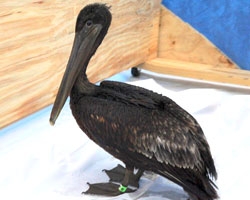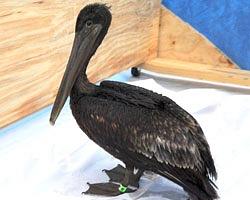U.S. pursues oil drilling in the Arctic Ocean
Dear EarthTalk: The oil industry is planning what some call a dangerous strategy of drilling for oil on the Outer Continental Shelf in the Arctic Ocean. What’s going on?
—Vera Bailey, New Hope, PA
In November 2011 the Obama administration began lifting the moratorium on off-shore drilling that had been imposed in the wake of the Deepwater Horizon disaster. Interior Secretary Ken Salazar announced a five year plan including 15 leases for oil development on Alaska’s Outer Continental Shelf and in the Gulf of Mexico. For now the East and West coasts of the continental U.S. have been spared from drilling, but environmentalists are particularly worried about opening up the fragile Alaskan Arctic to off-shore rigs.
“This five-year program will make available for development more than three-quarters of undiscovered oil and gas resources estimated on the [Outer Continental Shelf], including frontier areas such as the Arctic, where we must proceed cautiously, safely and based on the best science available,” Salazar told reporters.
Republicans were incensed that more acreage was not being made available for off-shore drilling, but environmentalists couldn’t believe what they were hearing for different reasons: In June 2011 the U.S. Geological Survey (USGS) had released a 292-page report commissioned by Interior Secretary Salazar “to identify the gaps in scientific or technical knowledge about how drilling in the Beaufort and Chukchi seas north of Alaska would affect the region,” reports Jerry Bellinson in Popular Mechanics. The report, Bellinson says, “details several areas where those gaps exist, including oil-spill cleanup technologies, basic mapping of currents and the effects of underwater noise on sea mammals.” Despite the USGS’s warnings, the Obama administration decided to proceed anyway.
“Drilling infrastructure permanently alters ocean floor habitats,” reports Defenders of Wildlife. “Drill rig footprints, undersea pipelines, dredging ship channels, and dumped drill cuttings—the rock material dug out of the oil or gas well—are often contaminated with drilling fluid used to lubricate and regulate the pressure in drilling operations.” The group adds that contaminated sediments are carried long distances by currents and can kill important small bottom-dwelling creatures at the bottom of the marine food chain.
Defenders also argues that spills, leaks and occasional BP-like catastrophes are unavoidable with off-shore oil drilling, if history is any guide. “Even with safety protocols in place, leaks and spills are inevitable—each year U.S. drilling operations send an average of 880,000 gallons of oil into the ocean.”
As for wildlife, off-shore drilling can have devastating effects even with no spills or leaks. “Seismic surveys conducted during oil and gas exploration cause temporary or permanent hearing loss, induce behavioral changes, and even physically injure marine mammals such as whales, seals and dolphins,” reports Defenders. “Construction noise from new facilities and pipelines is also likely to interfere with foraging and communication behaviors of birds and mammals. Because they are at the top of the food chain, many marine mammals will be exposed to the dangers of bioaccumulation of organic pollutants and metals.” And off-shore drilling only adds insult to injury as far as Defenders is concerned: “In the face of the climate crisis, the U.S. needs to look for ways to decrease petroleum consumption, not…increase it.”
Comments
There are 0 comments on this post













